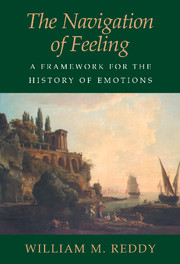Book contents
- Frontmatter
- Contents
- Preface
- Part I What are Emotions?
- Part II Emotions in History: France, 1700–1850
- 5 The Flowering of Sentimentalism (1700–1789)
- 6 Sentimentalism in the Making of the French Revolution (1789–1815)
- 7 Liberal Reason, Romantic Passions (1815–1848)
- 8 Personal Destinies: Case Material of the Early Nineteenth Century
- Conclusion
- Appendix A Detailed Review of Anomalous Cases from the Gazette des Tribunaux Sample
- Appendix B Detailed Review of Anomalous Cases from the Tribunal Civil de Versailles Sample
- References
- Index
6 - Sentimentalism in the Making of the French Revolution (1789–1815)
Published online by Cambridge University Press: 07 September 2009
- Frontmatter
- Contents
- Preface
- Part I What are Emotions?
- Part II Emotions in History: France, 1700–1850
- 5 The Flowering of Sentimentalism (1700–1789)
- 6 Sentimentalism in the Making of the French Revolution (1789–1815)
- 7 Liberal Reason, Romantic Passions (1815–1848)
- 8 Personal Destinies: Case Material of the Early Nineteenth Century
- Conclusion
- Appendix A Detailed Review of Anomalous Cases from the Gazette des Tribunaux Sample
- Appendix B Detailed Review of Anomalous Cases from the Tribunal Civil de Versailles Sample
- References
- Index
Summary
In 1780 Jeanne-Marie Phlipon, the young daughter of an engraver, married Jean-Marie Roland, a well-off inspector of manufactures. We have already seen that they lived their own courtship and marriage as if they were characters in a kind of sentimentalist novel. When the Revolution broke out nine years later, Jeanne-Marie was much more engaged and more resourceful than her husband in taking part in the new world of politics that opened up. (On her life, see May 1970.) She wrote articles for Jacques-Pierre Brissot's successful new paper, Le Patriote français. She urged her husband into politics, taking a large role in shaping his views and determining his allies. On 15 January 1793, when Roland resigned as minister of interior, he read out before the Convention a forceful defense of his stewardship and a call for a full reorganization of the government. But the Convention, preoccupied with the trial of Louis XVI, ignored his recommendations. The manuscript of that speech, which has survived, was written in his wife's hand. The Rolands had by this time ranged themselves with the moderates, the so-called Girondins, who opposed the execution of the king. The king, however, was condemned to die shortly afterward, and mounted the scaffold on 21 January. In the subsequent months, disagreements between the Girondins and their chief rivals, the rising Jacobin faction, only worsened. Party rivalry spread to the provinces, breaking out in open violence in some cases. During these troubled months, the Rolands kept a low profile.
Information
- Type
- Chapter
- Information
- The Navigation of FeelingA Framework for the History of Emotions, pp. 173 - 210Publisher: Cambridge University PressPrint publication year: 2001
